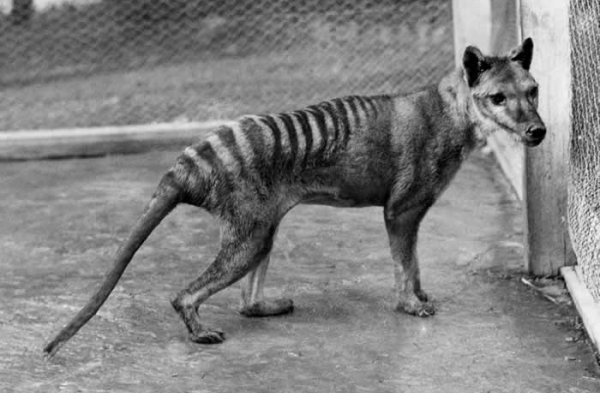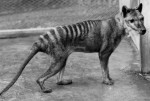 The word extinction has shown up several times in the news lately regarding the population status of some wildlife species. All too often we can identify species that have been deemed extinct, but we are not given an explanation of how this came to be. Historically, or I should say prehistorically, we know that a meteor striking the earth and an ice age contributed to the extinction of thousands of species. Note that these catastrophic events were natural disasters. However, what about the extinctions as of late? Internationally, we still experience natural disasters all the time, but what is their actual impact on species survival? Are humans now the catalyst to extinctions?
The word extinction has shown up several times in the news lately regarding the population status of some wildlife species. All too often we can identify species that have been deemed extinct, but we are not given an explanation of how this came to be. Historically, or I should say prehistorically, we know that a meteor striking the earth and an ice age contributed to the extinction of thousands of species. Note that these catastrophic events were natural disasters. However, what about the extinctions as of late? Internationally, we still experience natural disasters all the time, but what is their actual impact on species survival? Are humans now the catalyst to extinctions?
Extinction of plant and animal species can be attributed to several causes: habitat loss;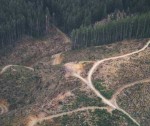 hunting/poaching; disease; and climate change. As human population increases more space is required for homes and agriculture. It is no surprise that human encroachment into designated wildlife areas, i.e. state and national parks, results in the clearing of thousands, if not millions, of acres of forest annually. Unsustainable Palm oil plantations in Malaysia have severely compromised the survival of the
hunting/poaching; disease; and climate change. As human population increases more space is required for homes and agriculture. It is no surprise that human encroachment into designated wildlife areas, i.e. state and national parks, results in the clearing of thousands, if not millions, of acres of forest annually. Unsustainable Palm oil plantations in Malaysia have severely compromised the survival of the 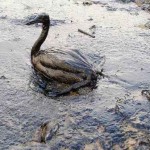 orangutan and proboscis monkey, as well as other species of plants, animals, and insects that inhabit these regions. Deforestation in the Amazon directly affects wildlife and indigenous tribes as they are both losing homeland. In addition, habitat loss via toxins introduced in the environment, like the oil spill in the Gulf, causes an area to no longer be able to sustain life.
orangutan and proboscis monkey, as well as other species of plants, animals, and insects that inhabit these regions. Deforestation in the Amazon directly affects wildlife and indigenous tribes as they are both losing homeland. In addition, habitat loss via toxins introduced in the environment, like the oil spill in the Gulf, causes an area to no longer be able to sustain life.
Poaching, or illegal hunting, is on the rise. Although some poaching is done to put food on the table of those less fortunate, a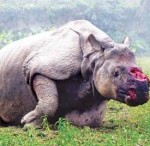 number of wildlife populations are being decimated to fuel the demand of illegal wildlife products. The need for rhino horn, shark fins, elephant ivory, tiger bones and blood, bear bile, etc. in practices such as Ancient Chinese Medicine are perpetuating the illegal killing of these magnificent animals. Only when the demand stops will the killing stop. However, there is also hunting/killing being carried out simply out of fear and misunderstanding. Wolves have been eradicated in the majority of their home range in the United States. Despite scientific evidence proving otherwise, wolves are hated by ranchers and wrongly
number of wildlife populations are being decimated to fuel the demand of illegal wildlife products. The need for rhino horn, shark fins, elephant ivory, tiger bones and blood, bear bile, etc. in practices such as Ancient Chinese Medicine are perpetuating the illegal killing of these magnificent animals. Only when the demand stops will the killing stop. However, there is also hunting/killing being carried out simply out of fear and misunderstanding. Wolves have been eradicated in the majority of their home range in the United States. Despite scientific evidence proving otherwise, wolves are hated by ranchers and wrongly 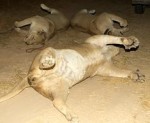 accused of killing domestic livestock. In addition, there is still a stigma that wolves are evil and people simply do not want them near their homes. Such was the case with the extinction icon the thylacine or Tasmanian tiger. Entire prides of African lions are being poisoned by Furadan. Cattle graziers and ranchers are using this deadly pesticide to contaminate carcasses and subsequently killing lions. The king is being annihilated simply out of fear.
accused of killing domestic livestock. In addition, there is still a stigma that wolves are evil and people simply do not want them near their homes. Such was the case with the extinction icon the thylacine or Tasmanian tiger. Entire prides of African lions are being poisoned by Furadan. Cattle graziers and ranchers are using this deadly pesticide to contaminate carcasses and subsequently killing lions. The king is being annihilated simply out of fear.
Regardless if it is via a bacterial, viral, or fungal route, disease is one of the leading causes of the decimation of our most precious wildlife. Bat populations in North America are suffering great losses at the hands of a fungus aptly named the White-nose syndrome. Likewise, amphibian species are dying off at an alarming rate due to the chytrid fungus. While common in other parts of the world, both of the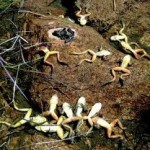 previously named fungi have been introduced into fragile non-native ecosystems by humans. The African clawed frog has been a popular animal used in medical testing facilities for decades. It is thought that either by escape or purposeful release, the invasion of this species has allowed for the chytrid fungus to infect and kill others. Similarly, it has been established that human cave explorers were the initial carriers of the White-nose fungus, contaminating millions of bats and collapsing entire populations. Not to be outdone, diseases like rabies and distemper are also spreading into wildlife populations with help from domestic counterparts. Vaccinating pets that are allowed outside, as well as controlling the population of canine and feline companions through spay and neuter programs will be crucial in containing such contagious diseases and thus saving wildlife.
previously named fungi have been introduced into fragile non-native ecosystems by humans. The African clawed frog has been a popular animal used in medical testing facilities for decades. It is thought that either by escape or purposeful release, the invasion of this species has allowed for the chytrid fungus to infect and kill others. Similarly, it has been established that human cave explorers were the initial carriers of the White-nose fungus, contaminating millions of bats and collapsing entire populations. Not to be outdone, diseases like rabies and distemper are also spreading into wildlife populations with help from domestic counterparts. Vaccinating pets that are allowed outside, as well as controlling the population of canine and feline companions through spay and neuter programs will be crucial in containing such contagious diseases and thus saving wildlife.
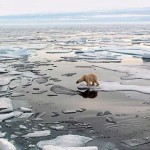 Climate change, whether a man-made or natural phenomenon, is happening. Melting polar ice caps, rising temperatures, and changing weather patterns are all negatively effecting wildlife. The Horn of Africa region is experiencing one of the worst droughts on record. Likewise, the waters surrounding the Arctic are warming causing a change in diversity of sea life. Marine mammals, whales, and sharks migrate to ocean areas specifically for feeding and parturition. It is not uncommon for individuals to be in poor physical condition by the time they reach such places. As ocean temperatures rise and currents change plankton that fish rely on, as well as the oxygen concentration in the water, decreases. No plankton means no fish, and no fish means no food for those migrating species; starvation becomes a reality. A side note, overfishing to meet commercial demands also contributes to decreasing fish numbers.
Climate change, whether a man-made or natural phenomenon, is happening. Melting polar ice caps, rising temperatures, and changing weather patterns are all negatively effecting wildlife. The Horn of Africa region is experiencing one of the worst droughts on record. Likewise, the waters surrounding the Arctic are warming causing a change in diversity of sea life. Marine mammals, whales, and sharks migrate to ocean areas specifically for feeding and parturition. It is not uncommon for individuals to be in poor physical condition by the time they reach such places. As ocean temperatures rise and currents change plankton that fish rely on, as well as the oxygen concentration in the water, decreases. No plankton means no fish, and no fish means no food for those migrating species; starvation becomes a reality. A side note, overfishing to meet commercial demands also contributes to decreasing fish numbers.
In 2009, conservationist and television personality Jeff Corwin published a compelling book 100 Heartbeats. A sad chronicle of the wildlife we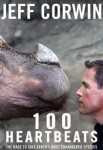 have lost, and what we stand to lose, this book chronicles those species whose current population is 100 or fewer individuals; species that teeter on the brink of extinction. This book is more than just a reminder; it is truly a call to action. Whether we want to admit it or not humans have become the driving force behind extinctions of wildlife, plant, and insect species. We are well aware of the consequences of our actions, but seem reluctant to make the change necessary to ensure the natural world we have today will be here tomorrow. Will 2012 be another year of loss, or will it be the turning point in conservation? Only you can decide.
have lost, and what we stand to lose, this book chronicles those species whose current population is 100 or fewer individuals; species that teeter on the brink of extinction. This book is more than just a reminder; it is truly a call to action. Whether we want to admit it or not humans have become the driving force behind extinctions of wildlife, plant, and insect species. We are well aware of the consequences of our actions, but seem reluctant to make the change necessary to ensure the natural world we have today will be here tomorrow. Will 2012 be another year of loss, or will it be the turning point in conservation? Only you can decide.
